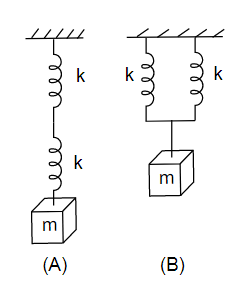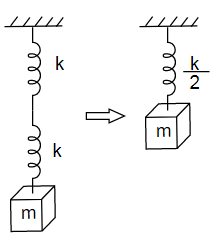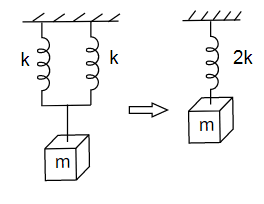
Two identical springs of constant K are connected in series and parallel as shown in figure. A mass m is suspended from them. The ratio of their frequencies of vertical oscillations will be

A. 2:1
B. 1:1
C. 1:2
D. 4:1
Answer
218.4k+ views
Hint: If two springs of constant \[{k_1}\] and \[{k_2}\] respectively is connected in parallel combination then the effective constant of the system will be\[{k_p} = {k_1} + {k_2}\] and for a series combination of the springs its will be \[{k_s} = \dfrac{{{k_1}{k_2}}}{{{k_1} + {k_2}}}\].
Formula used:
\[f = \dfrac{1}{{2\pi }}\sqrt {\dfrac{k}{m}} \]
Where, f = Frequency of oscillation, k= Springs constant and m = Mass suspended to spring
Complete step by step solution:
Given here are two spring-mass systems each having a combination of two springs of constant k, we have to find the ratio of their frequencies.
The frequency of oscillation is given by,
\[f = \dfrac{1}{{2\pi }}\sqrt {\dfrac{k}{m}} \,.......(1)\]
Where, f = Frequency of oscillation, k= Springs constant and m = Mass suspended to spring
In figure A two springs each having constant k are connected in series combination and the effective constant of the system will be,
\[{k_s} = \dfrac{{kk}}{{k + k}} \Rightarrow {k_s} = \dfrac{k}{2}\]

Image 1 : Equivalent diagram of system A
Using equation (1) frequency of oscillation of the system in figure A will be,
\[{f_A} = \dfrac{1}{{2\pi }}\sqrt {\dfrac{k}{{2m}}} \,.......(2)\]
The effective constant for two springs of constant k each in figure B will be,
\[{k_p} = k + k = 2k\]

Image 2 : Equivalent diagram of system B
The frequency of oscillation of the system will be,
\[{f_B} = \dfrac{1}{{2\pi }}\sqrt {\dfrac{{2k}}{m}} \,.......(3)\]
From equations (2) and (3) we get,
\[\dfrac{{{f_A}}}{{{f_B}}} = \dfrac{1}{{2\pi }}\sqrt {\dfrac{k}{{2m}}} \, \times 2\pi \sqrt {\dfrac{m}{{2k}}} \,\]
The above equation can be written as,
\[\dfrac{{{f_A}}}{{{f_B}}} = \sqrt {\dfrac{k}{{2m}} \times \dfrac{m}{{2k}}} \Rightarrow \dfrac{{{f_A}}}{{{f_B}}} = \dfrac{1}{2}\]
Hence, the ratio of frequency is 1:2. Thus, option C is the correct option.
Note: If the external force is acting on a series combination of springs then the force is the same on each spring without any change in magnitude and the deformation of the system will be the sum of individual deformation of each spring. In parallel combinations of the springs, deformation of the system is common deformation among all springs.
Formula used:
\[f = \dfrac{1}{{2\pi }}\sqrt {\dfrac{k}{m}} \]
Where, f = Frequency of oscillation, k= Springs constant and m = Mass suspended to spring
Complete step by step solution:
Given here are two spring-mass systems each having a combination of two springs of constant k, we have to find the ratio of their frequencies.
The frequency of oscillation is given by,
\[f = \dfrac{1}{{2\pi }}\sqrt {\dfrac{k}{m}} \,.......(1)\]
Where, f = Frequency of oscillation, k= Springs constant and m = Mass suspended to spring
In figure A two springs each having constant k are connected in series combination and the effective constant of the system will be,
\[{k_s} = \dfrac{{kk}}{{k + k}} \Rightarrow {k_s} = \dfrac{k}{2}\]

Image 1 : Equivalent diagram of system A
Using equation (1) frequency of oscillation of the system in figure A will be,
\[{f_A} = \dfrac{1}{{2\pi }}\sqrt {\dfrac{k}{{2m}}} \,.......(2)\]
The effective constant for two springs of constant k each in figure B will be,
\[{k_p} = k + k = 2k\]

Image 2 : Equivalent diagram of system B
The frequency of oscillation of the system will be,
\[{f_B} = \dfrac{1}{{2\pi }}\sqrt {\dfrac{{2k}}{m}} \,.......(3)\]
From equations (2) and (3) we get,
\[\dfrac{{{f_A}}}{{{f_B}}} = \dfrac{1}{{2\pi }}\sqrt {\dfrac{k}{{2m}}} \, \times 2\pi \sqrt {\dfrac{m}{{2k}}} \,\]
The above equation can be written as,
\[\dfrac{{{f_A}}}{{{f_B}}} = \sqrt {\dfrac{k}{{2m}} \times \dfrac{m}{{2k}}} \Rightarrow \dfrac{{{f_A}}}{{{f_B}}} = \dfrac{1}{2}\]
Hence, the ratio of frequency is 1:2. Thus, option C is the correct option.
Note: If the external force is acting on a series combination of springs then the force is the same on each spring without any change in magnitude and the deformation of the system will be the sum of individual deformation of each spring. In parallel combinations of the springs, deformation of the system is common deformation among all springs.
Recently Updated Pages
Two discs which are rotating about their respective class 11 physics JEE_Main

A ladder rests against a frictionless vertical wall class 11 physics JEE_Main

Two simple pendulums of lengths 1 m and 16 m respectively class 11 physics JEE_Main

The slopes of isothermal and adiabatic curves are related class 11 physics JEE_Main

A trolly falling freely on an inclined plane as shown class 11 physics JEE_Main

The masses M1 and M2M2 M1 are released from rest Using class 11 physics JEE_Main

Trending doubts
JEE Main 2026: Application Form Open, Exam Dates, Syllabus, Eligibility & Question Papers

Derivation of Equation of Trajectory Explained for Students

Hybridisation in Chemistry – Concept, Types & Applications

Understanding the Angle of Deviation in a Prism

Understanding Collisions: Types and Examples for Students

Understanding Atomic Structure for Beginners

Other Pages
JEE Advanced Marks vs Ranks 2025: Understanding Category-wise Qualifying Marks and Previous Year Cut-offs

Units And Measurements Class 11 Physics Chapter 1 CBSE Notes - 2025-26

NCERT Solutions For Class 11 Physics Chapter 8 Mechanical Properties Of Solids

Motion in a Straight Line Class 11 Physics Chapter 2 CBSE Notes - 2025-26

NCERT Solutions for Class 11 Physics Chapter 7 Gravitation 2025-26

How to Convert a Galvanometer into an Ammeter or Voltmeter




